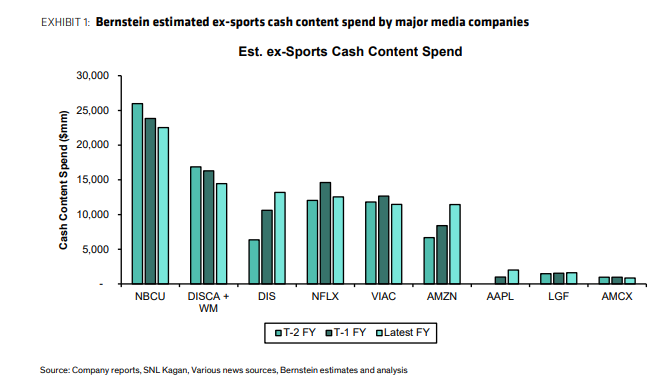Analyst: NBCU Tops Media Cos. With $22.5 Billion in Content Spending Excluding Sports
Combination of Warner Bros. and Discovery would be second at $14.5 billion

Comcast’s NBCUniversal is the biggest cash spender when it comes to non sports content, according to a new report from Todd Juenger, analyst at Sanford C. Bernstein.
According to Juenger’s accounting, NBCU’s spending, including Sky reached $22.5 billion in 2020.
The combination of Warner Bros. and Discovery would be second at $14 billion, followed by Disney at $13.2 billion, Netflix at $12.5 billion, ViacomCBS, at $11.5 billion and Amazon tied at $11.5 billion.

He noted that, according to company reports and other sources, only Disney and Amazon, and to a lesser extent Netflix, increased non-sports cash content investment over the past three years.
Juenger said he put together the report because to many investors spending is a key to success as the TV industry turns to streaming. He looked at cash spending, rather than amortization.
“We understand the more important investment analysis is forward-looking estimates," said Juenger. "But it's impossible to create and debate forward estimates without a rigorous and commonly agreed baseline to start from."
Also Read: ‘We Can Compete With Netflix, Disney,’ Says David Zaslav
The smarter way to stay on top of broadcasting and cable industry. Sign up below
But when it comes to streaming, not all content is created equally, particularly when it comes to sports.
Juenger said he excluded sports spending because unlike most other entertainment programming, it is watched live, the media company doesn’t own the content and the rights are usually country specific.
Another factor that needs to be taken into consideration is how much content each company needs to program their linear networks.
“A commonly expressed view is that legacy TV networks companies can simply migrate the monetization of their content investment from linear networks to streaming. The flaw in that logic is, those companies still must program the networks, 24/7. They can, and should, apportion less to linear. But this will drive lower advertising and distribution revenue,” Juenger noted.
Juenger also said that some content is shared across channels, such as movies, which sometimes appear first in theaters, then on streaming services. Similarly some TV content starts on a streaming service, and then runs on a traditional linear network.
Jon has been business editor of Broadcasting+Cable since 2010. He focuses on revenue-generating activities, including advertising and distribution, as well as executive intrigue and merger and acquisition activity. Just about any story is fair game, if a dollar sign can make its way into the article. Before B+C, Jon covered the industry for TVWeek, Cable World, Electronic Media, Advertising Age and The New York Post. A native New Yorker, Jon is hiding in plain sight in the suburbs of Chicago.

